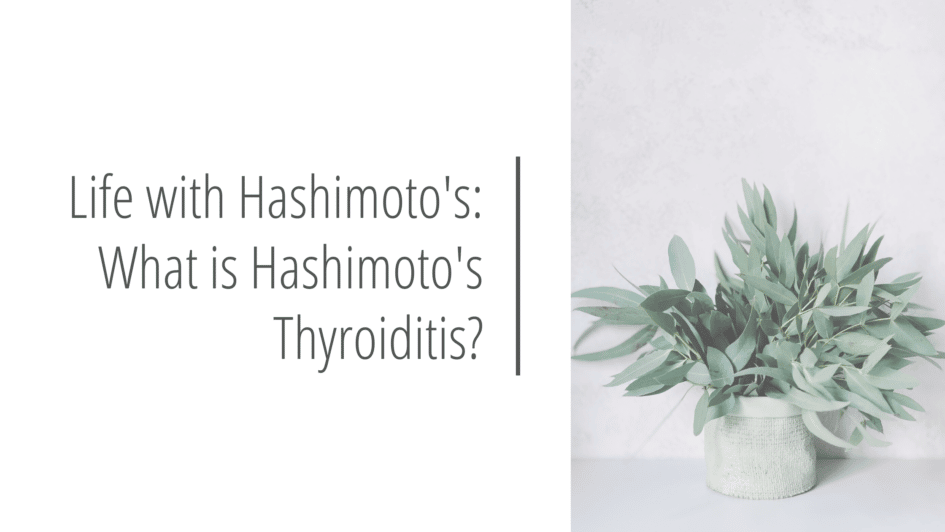Since I started this blog, I’ve wanted to write about life with Hashimoto’s Thyroiditis. So I’m finally doing it and I’ve decided to start a blog series called Life with Hashimoto’s, where I will talk about the ups and downs of the disease. (For those of you that don’t know, I was diagnosed with Hashimoto’s Thyroiditis in 2016. That diagnosis is what started my anti-diet journey.)
Table of Contents
What is Hashimoto’s Thyroiditis?
To start off the series, I first want to explain what Hashimoto’s is. Hashimoto’s is a type of auto-immune disease that causes hypothyroidism. An auto-immune disease is present in the body when the immune system decides to attack a certain system or a certain part of the body. Auto-immune diseases cannot be cured and are not caused by something the individual with the disease did. In Hashimoto’s, the immune system attacks the thyroid gland, which is found in the base of your neck. When the immune system attacks the thyroid gland, it damages the cells that produce the thyroid hormones (T3 and T4), which impacts the production and distribution of those hormones. Depending on the severity of a person’s Hashimoto’s, the thyroid gland might still produce some hormones or the gland might not produce any at all.
This is important because the thyroid hormones are a very necessary part of the human body. The thyroid hormones contribute to the body’s overall metabolism, heart health, muscle health, digestive function, brain function, bone health, and more.
Examples of other autoimmune diseases:
Hashimoto’s isn’t the only autoimmune disease out there. To help you better understand Hashimoto’s, I want to give you some other examples.
- Type 1 Diabetes: T1DM occurs when the immune system attacks the beta cells in the pancreas that are responsible for insulin production. Insulin is a vital hormone that is responsible for pulling glucose out of the blood and into the body’s cell. In people with type 1 diabetes, they do not produce any insulin, which means they are reliant on insulin from external sources such as a pump, in order to survive.
- Rheumatoid Arthritis: RA is an autoimmune disease where the immune system attacks the joints, causing chronic inflammation and joint pain. The inflammation caused by RA can lead to permanent bone degradation and joint deformity.
- Multiple Sclerosis: MS is an autoimmune disease where the immune system attacks the cells (myelin) that protect the nervous system. When the protective covering (also referred to as sheath) starts degrading, this causes numbness or weakness, tingling, lack of coordination, tremors, fatigue, dizziness, vision problems, and more.
- Celiac Disease: Celiac is also an auto-immune disease, which is surprising to most people. In Celiac Disease, the body has an immune reaction to gluten, which is a protein found in wheat, rye, and barley. When the body reacts to gluten, symptoms can include intestinal distress, unintended weight loss, decrease in bone density, anemia, joint pain, nervous system issues, and more.
What are the signs and symptoms of Hashimoto’s?
- Chronic fatigue
- Digestion issues
- Increased menstrual pain and bleeding
- Unexpected weight gain
- Hair loss
- Decreased sensitivity to the cold
- Muscle weakness
- Muscle and joint pain
- Depression
- Gaps in memory or memory lapses
- Brittle nails
- and more
How is Hashimoto’s Treated?
Hashimoto’s is treated with a drug called levothyroxine, which is a synthetic form of the thyroid hormone T4. The drug is taken orally every day and is used to provide the body with T4. Theoretically, this provides people with Hashimoto’s the level of thyroid hormones that are needed to function properly. I say theoretically because taking levothyroxine does not cure Hashimoto’s and the symptoms are still experienced.
In order to keep the thyroid hormone levels stable in the body, people with Hashimoto’s need to meet with their endocrinologist on a yearly basis. These appointments typically involve discussing current symptoms and having labs done to review the current hormone levels in the body. If the levels are off, which is highly likely because the body is always changing, then the dose of levothyroxine is changed accordingly.
Despite common thought and despite what Dr. Google says, there is no diet that can treat Hashimoto’s. People tend to get Hashimoto’s Thyroiditis confused with hypothyroidism. However, they are not the same thing, which means they are not treated the same way. Hypothyroidism is simply a lack of thyroid hormone production secondary to a lack of iodine intake. On the other hand, with Hashimoto’s, hypothyroidism is actually caused by Hashimoto’s itself.
This means that Hashimoto’s cannot be “fixed” or treated by increasing the intake of iodine. In fact, research shows that iodine can be dangerous for individuals with Hashimoto’s because it can actually exacerbate the symptoms and can decrease the production of thyroid hormones if the thyroid is still producing small amounts.
Sadly, there’s no quick fix to Hashimoto’s. There’s no cure for Hashimoto’s. It’s something that has to be dealt with on a daily basis and I think that’s something people without Hashimoto’s can’t quite grasp.
What to expect from the Life with Hashimoto’s blog series:
With this blog series, I hope to educate the individuals who read my blog on what Hashimoto’s is and what people with Hashimoto’s have to deal with. I also hope to create a space where other people with Hashimoto’s (I know quite a few!) can feel heard and can relate to the things I write about. Every person’s battle with Hashimoto’s is different, but it’s comforting and helpful to hear about each person’s journey.
Stay tuned for more posts about Hashimoto’s?
Thanks for reading!
Sincerely,
Rachel Beiler, MHS, RD, LDN


2 Pingbacks